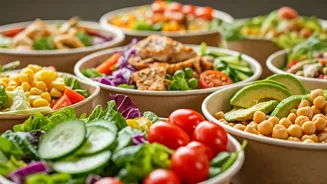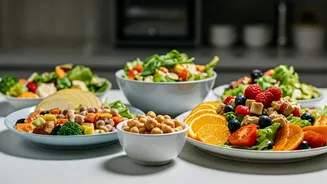Salad Introduction
Salads are often seen as a healthy and refreshing meal choice. They provide a wonderful foundation for incorporating a variety of nutrients from different
sources, creating a balanced and flavorful eating experience. The beauty of salads lies in their adaptability, allowing you to use a wide variety of fresh ingredients, from crisp greens to colorful vegetables, and then enhancing them with a selection of dressings and toppings. Salads can easily be customized to meet dietary needs and preferences, and they also provide a convenient way to integrate more fruits and vegetables into your daily diet. Incorporating salads into your diet can not only enhance your overall health, but it also gives you a wide range of tastes and textures that make every meal unique.
Refreshing Green Salads
Starting with the basics, green salads form a perfect base for many meals. They offer a light and airy texture, making them ideal as an appetizer or a light meal. To construct a green salad, begin with a foundation of mixed greens, such as romaine lettuce, spinach, or kale. Add components such as cucumbers, bell peppers, tomatoes, and red onions for freshness and texture. Incorporate a simple vinaigrette dressing like balsamic or lemon vinaigrette. You can add a protein, like grilled chicken or chickpeas, to make it more filling. Some recipes add fruits like apples or berries to complement the vegetables. Green salads are often the easiest to make and can be adapted to individual tastes and available ingredients.
Pasta Salad Delights
Pasta salads combine the satisfaction of pasta with the benefits of a salad. You can use different pasta shapes and ingredients to customize the experience. Start with cooked pasta, like penne, rotini, or farfalle. Then, add a variety of colorful vegetables, such as cherry tomatoes, broccoli florets, and olives. A creamy dressing, like a mayonnaise-based or a pesto, is a popular choice for pasta salads. You can also include proteins like cheese or salami to add extra flavor. Pasta salads are perfect for picnics, potlucks, or meal prep. They are easily made in advance and remain flavorful even after being chilled. They also give you the freedom to mix and match ingredients to meet your needs and preferences.
Fruit Salad Sensations
Fruit salads offer a sweet and refreshing experience, perfect for a light dessert or a side dish. Start with a selection of your favorite fruits, like berries, melon, and citrus. These salads often don't need any other ingredient, as the natural sweetness of the fruits makes them enjoyable on their own. For some recipes, you can add a simple dressing, like honey or a light syrup. You can garnish with fresh mint or a squeeze of lime juice. Fruit salads are best made just before serving to maintain the freshness and texture of the fruit. This ensures that each bite has the maximum flavor and is a true celebration of the natural sweetness of the fruits.
Hearty Grain Bowls
Grain bowls have become very popular in recent times, offering a way to create a well-balanced and nutritious meal. Start with a base of grains like quinoa, brown rice, or farro. Add roasted vegetables, such as sweet potatoes or Brussels sprouts, and proteins like grilled tofu or chicken. To add a bit more flavor, you can add a tahini dressing or a chimichurri sauce. Grain bowls can be assembled in advance, making them an excellent choice for meal prepping. Grain bowls are customizable and give you the space to mix and match ingredients to suit your taste and dietary needs. They are also highly satisfying and give your body the essential nutrients it requires.
Mediterranean Salads
Mediterranean salads bring together the vibrant flavors of the Mediterranean region, often starring fresh vegetables, herbs, and healthy fats. A traditional Greek salad includes ingredients such as tomatoes, cucumbers, red onions, feta cheese, and olives. Adding a simple lemon vinaigrette or a drizzle of olive oil can add more flavor. You can enhance the flavor profile by including elements like chickpeas, marinated artichoke hearts, or sun-dried tomatoes. Mediterranean salads are known for their fresh and vibrant flavors, making them an ideal choice for a light and refreshing meal. They also provide a good mix of nutrients, including fiber, healthy fats, and antioxidants.
Salad Dressings Galore
The dressing determines the flavor profile of the salads, so choosing the right dressing can make a big difference. Many different options are available, from classic vinaigrettes to creamy dressings. Vinaigrettes, which are made by whisking together oil, vinegar, and other flavorings, are a light and tangy choice that is excellent with green salads. Creamy dressings, such as those made with mayonnaise or yogurt, bring richness to salads. Popular options include ranch, Caesar, and blue cheese dressings. Many dressings can be made at home, providing you with control over the ingredients and taste. Experimenting with different dressings allows you to adapt salads to your tastes and creates a wide range of flavor experiences.
Adding Protein to Salads
Adding protein to salads enhances the nutritional value, helping make a fulfilling meal. Proteins can take the form of lean meats, such as grilled chicken or fish, or plant-based proteins, such as beans, lentils, or tofu. Hard-boiled eggs and cheese provide additional protein and flavor. To ensure that salads are balanced, think about combining various protein sources with healthy fats and fiber. Protein helps give the body energy and helps repair cells, and adding protein to your salad helps make it a wholesome and filling dish that will keep you content for hours. When you add protein, you not only improve the salad's nutritional profile, but you also elevate the overall eating experience.
Salads for Weight Loss
Salads can be a beneficial choice for weight loss because they are typically packed with nutrients and low in calories. Using fresh vegetables and leafy greens as the foundation of your salads is the best option because they are packed with fiber, which helps you feel full and helps control your appetite. Be careful with dressings and toppings, as they can add hidden calories and fats. Choosing light vinaigrettes or making your own dressings can help you avoid unwanted calories. When creating a salad for weight loss, make sure to add a source of protein and healthy fats. Salads can be an integral component of a weight-loss diet when they are created with the right ingredients and attention to portion control.
Salads for Every Season
Salads are very adaptable to different seasons, as you can use seasonal ingredients. In summer, you can enjoy salads featuring fresh tomatoes, cucumbers, and berries. Fall salads might include roasted vegetables such as sweet potatoes and butternut squash, along with apples and pecans. Winter salads can be made with hearty greens, citrus fruits, and root vegetables. Spring salads could incorporate fresh asparagus, peas, and radishes. Using ingredients that are in season not only guarantees the most flavorful and nutritious salads, but it also supports local farmers and gives you a chance to enjoy the bounty of the season.
Tips for Great Salads
To make delicious salads, use high-quality, fresh ingredients. Choose the ripest and most flavorful fruits and vegetables available. Wash and dry all greens and vegetables thoroughly to remove any excess moisture, which can make your salad soggy. Cut all the ingredients into bite-sized pieces for ease of eating. When adding dressing, dress the salad right before you serve it to prevent wilting. You can also mix the dressing with the greens and vegetables just before serving. To enhance the flavor of your salads, try toasting nuts or seeds, using fresh herbs, and adding a squeeze of fresh citrus juice. By applying these tips, you can elevate your salads from simple side dishes to main course meals.
Salad Variations
Salads can include a variety of different flavors and ingredients, so you can make them as simple or as complex as you want. Taco salads, for example, incorporate seasoned ground meat, tortilla chips, cheese, and a flavorful dressing. Caprese salads offer a classic combination of fresh mozzarella, tomatoes, and basil, drizzled with balsamic glaze. Cobb salads include a mix of chicken, bacon, eggs, and blue cheese. The diversity of salad variations ensures that there's a salad for everyone. From Asian-inspired salads with sesame-ginger dressing to fruit-filled creations, these variations give you endless opportunities to experiment and improve your culinary skills.
Salad-Making Techniques
Preparing salads is simple, but certain techniques can improve the outcome. First, make sure you properly wash and dry all ingredients to avoid sogginess. Use a salad spinner to remove extra water. To achieve optimal flavor, dress the salad right before serving. However, you can make the dressing in advance to save time. When making a salad with layered components, start with the greens and then add the other ingredients. You can also gently toss the salad to distribute the dressing equally. For the best result, choose a light and creamy dressing when the salad has various ingredients with different flavors. With proper preparation, you can turn a simple salad into a culinary masterpiece.
Salad and Nutrition
Salads are known to provide the body with essential nutrients, making them a very beneficial part of a balanced diet. Leafy greens are a great source of vitamins A, C, and K, as well as several minerals and fiber. Including other vegetables and fruits gives you even more vitamins, minerals, and antioxidants. Different proteins in salads, such as chicken or beans, give you essential amino acids. The fiber in salads contributes to a healthy digestive system, while the healthy fats from ingredients like avocados or nuts promote heart health. By eating a wide range of ingredients, salads provide a complete range of nutrients that are essential for overall health and well-being.
Conclusion: Embrace Salads!
Salads offer numerous benefits and versatility for any meal. From simple green salads to elaborate creations with various ingredients, salads can cater to any taste and dietary requirement. They are healthy, easy to prepare, and a wonderful way to enjoy fresh and flavorful meals. By being creative with the ingredients, dressing, and toppings, you can discover a lot of salad combinations to enjoy on different occasions. Embrace the world of salads and include them in your diet, and you'll soon experience their many nutritional and culinary benefits. This change can lead to a healthier and more satisfying way of eating.












